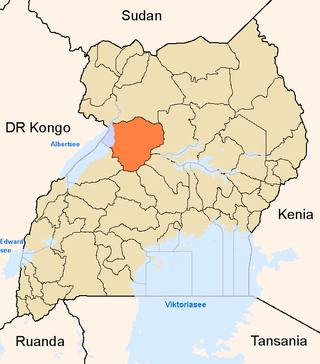
The politics of Uganda occurs in an authoritarian context. Since assuming office in 1986 at the end of the Ugandan civil war, Yoweri Museveni has ruled Uganda as an autocrat. Political parties were banned from 1986 to 2006 in the wake of the 2005 Ugandan multi-party referendum which was won by pro-democracy forces. Since 2006, Museveni has used legal means, patronage, and violence to maintain power.

Kamuli District is a district in the Eastern Region of Uganda. The town of Kamuli is the site of the district headquarters.

The system of education in Uganda has a structure of 7 years of primary education, 6 years of secondary education, and 3 to 5 years of post-secondary education. Education in Uganda is administered in English. All throughout the levels in the education structure, modules are taught and assessed in English. The government of Uganda recognizes education as a basic human right and continues to strive to provide free primary education to all children in the country. However, issues with funding, teacher training, rural populations, and inadequate facilities continue to hinder the progress of educational development in Uganda. Girls in Uganda are disproportionately discriminated against in terms of education; they face harsher barriers when trying to gain an education and it has left the female population disenfranchised, despite government efforts to close the gap.

Abdu Katuntu is a Ugandan politician, lawyer currently serving as the Member of Parliament for Bugweri County, Bugweri District.
The Iwokrama International Centre for Rain Forest Conservation and Development is an autonomous non-profit institution established by Guyana and the Commonwealth. It "exists to promote the conservation and the sustainable and equitable use of tropical rain forests in a manner that leads to lasting ecological, economic, and social benefits to the people of Guyana and to the world in general, by undertaking research, training, and the development and dissemination of technologies".

Women of Uganda Network (WOUGNET) also known as Women of Uganda Network Development Limited is Ugandan non-governmental organization that aids women and women's organisations in the use and access of information and communication technologies (ICTs) to share information and address issues their concerns such as gender norms, advocating for their rights and building communities and businesses through education.

The Ministry of Finance, Planning and Economic Development (MoFPED) is a cabinet-level government ministry of Uganda. Its mandate is to formulate sound economic and fiscal policies, mobilize resources for the implementation of government programmes, disburse public resources as appropriated by Parliament, and account for their use in accordance with national laws and international best practices. The cabinet minister of finance is Matia Kasaija. MoFPED was created by the 1995 Constitution of Uganda and derives its power from the Constitution and related acts of parliament, including the 2001 Budget Act and the 2003 Public Finance and Accountability Act. The current Director of Economic Affairs in the Ministry of Finance, Planning and Economic Development of Uganda is Lawrence Kiiza.
Community-based monitoring (CBM) is a form of public oversight, ideally driven by local information needs and community values, to increase the accountability and quality of social services such as health, development aid, or to contribute to the management of natural resources. Within the CBM framework, members of a community affected by a social program or environmental change track this change and its local impacts, and generate demands, suggestions, critiques and data that they then act on, including by feeding back to the organization implementing the program or managing the environmental change. For a Toolkit on Community-Based Monitoring methodology with a focus on community oversight of infrastructure projects, see www.communitymonitoring.org. For a library of resources relating to community-based monitoring of tropical forests, see forestcompass.org/how/resources.
Ghana'sMinistry of Food and Agriculture (MOFA) is the government agency responsible for the development and growth of agriculture in the country. The jurisdiction does not cover the cocoa, coffee, or forestry sectors. The primary organisation and main area of the presidential administration of Ghana is the nation's Ministry of Food and Agriculture (MOFA), which is in charge of creating and carrying out policies and plans for the agricultural sector within the framework of an efficient national socio-economic development and prosperity agenda. The Ministry's plans and programmes are created, coordinated, and put into effect using frameworks for policy and strategy using a sector-wide approach. The Food and Agriculture Sector Development Policy II and the Medium Term Agriculture Sector Investment Plan were both developed with the aid of MOFA in relation to this.

The Nepalese Ministry of Minister of Industry, Commerce and Supplies is a governmental body of Nepal to monitor and manage industries of the country.
Extreme poverty is defined as living on less than US$2.50 purchasing power parity. Uganda has made significant progress in eradicating poverty and achieved the first millennium development goal of halving the number of people in extreme poverty. Uganda was listed as the 9th most successful country in Africa as regards poverty eradication. The percentage of Ugandans living in absolute poverty has been on a substantial decline, and the finance ministry in the country projected that the extreme poverty level will be reduced to 10% in the future. This success has been attributed to the deliberate efforts to combat poverty in the country by numerous national strategies that are explained below.

The Uganda National Health Users'/Consumers' Organization or Uganda National Health Consumers' Organisation (UNHCO) is a Ugandan nonprofit organization established in 1999 to advocate for the realization of the right to health for all Ugandans.

Kiira Motors Corporation or KMC is a State Enterprise in Uganda established to champion the Development of the Domestic Automotive Value Chain for job and wealth creation and commercialize the Kiira Electric Vehicle Project. The Equity Partners are the Government of the Republic of Uganda represented by the Ministry of Science, Technology and Innovation, Office of the President holding 96% of the initial stock and Makerere University holding 4%.

The sub-counties of Uganda are divided into parishes, which are further divided into villages. These parishes are governed by a local council II (LCII) committee and parish chief. The parish chief is a government employee that provides technical leadership to the LCII. LCIIs are made up all of the chairmen from the village local council I (LCI) committees in the parish and are responsible for settling land disputes and community outreach.
Reach A Hand, Uganda (RAHU) is a youth serving nonprofit organisation based in Uganda that focuses on youth empowerment programs with an emphasis on, Sexual Reproductive Health Rights (SRHR) and Advocacy of young people between the ages of 10–30 years including HIV/AIDS awareness and prevention ,youth livelihood promotion. RAHU works with the goal of increasing access to information and services relating to SRHR for young people so as to empower them live healthy, focused and productive lives. Reach A Hand Uganda's efforts are timely to make a contribution to ensuring that every young person in Uganda can access accurate information to aid and direct them in taking that crucial life decision regarding their life skills and development, and sexual reproductive health and rights.
Aisha Sekindi is a Ugandan educator and legislator. As of February 2022, she serves as Uganda's Minister of State for Water and the woman representative for Kalungu district in Uganda's eleventh parliament. She replaced Hon. Ronald Kibuule who handed over the office in July 2021. She held the same position in Uganda's tenth parliament. Politically, she is affiliated to the National Resistance Movement under whose ticket she contested in the 2016 general election, achieving victory over Aisha Naluyati Waligo of the Democratic Party Uganda (DP).
Amos Lugoloobi is a Ugandan politician. He is currently the state minister for finance and planning and the representative member for Ntenjeru north, Kayunga District in the Ugandan 11th Parliament.

Amon Ashaba Mwiine is a Ugandan gender activist and lecturer at the School of Women and Gender Studies, Makerere University. He went to Stellenbosch University, South Africa where he attained his PhD (Sociology). He is a trainer with Gender Responsive Researchers Equipped for Agricultural Transformation (GREAT) on aspects of Masculinities and Agriculture and Gender Transformative Approaches.
East Madi Wildlife Reserve is a protected area located in Adjumani District in Uganda, in the Madi sub-region. It covers an area of 831 km2. It is managed by Uganda Wildlife Authority under the supervision of Ministry of Tourism, Wildlife and Antiquities. It was established as a reserve in 2002.

Musoma Central Forest is located in Masindi, Uganda. The Forest Reserve showcases Uganda's landscape, wildlife, and culture.









